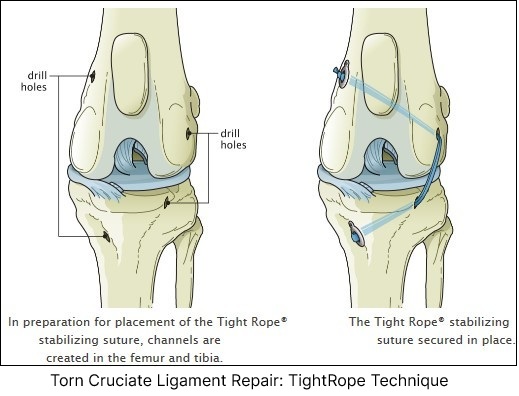Home | Surgical Info | Cranial Cruciate Ligament Repair: TightRope
Cranial Cruciate Ligament Repair: TightRope
Keywords:
Cranial Cruciate Ligament Repair: TightRope
Cranial Cruciate Ligament (CCL) injuries are one of the most common orthopedic problems in dogs, leading to pain, instability, and arthritis. The TightRope® procedure is an advanced surgical technique designed to restore stability to the knee joint using a minimally invasive approach. This page provides a comprehensive guide to CCL injuries, treatment options, and how the TightRope® procedure can help improve your pet's mobility and quality of life.
What is the Cranial Cruciate Ligament (CCL)?
The cranial cruciate ligament (CCL) is a major stabilizing structure in the stifle (knee) joint of dogs, similar to the anterior cruciate ligament (ACL) in humans.
Inside the knee, there are two cruciate ligaments: the cranial cruciate ligament and the caudal cruciate ligament. They are called "cruciate" because they cross over each other in the middle of the knee.
When the CCL is torn or injured, the tibia (shin bone) slides forward relative to the femur (thigh bone), resulting in a "positive drawer sign."
Dogs with a CCL injury experience joint instability, pain, cartilage damage, and progressive osteoarthritis (OA), which significantly affects their mobility.
What Are the Treatment Options for a Torn CCL?
Featured Resources

We Welcome New Patients!
We're always happy to give your furry friend care at our hospital. Get in touch today!
Contact UsIn most cases, surgical stabilization of the knee joint is necessary, particularly for larger or more active dogs.
Surgery is generally recommended as soon as possible to minimize permanent joint damage and relieve pain.
Various surgical techniques exist for repairing CCL injuries, each with its own advantages and considerations.
Your veterinarian will guide you in selecting the most appropriate surgical option based on your pet's size, activity level, and overall health.
Other common surgical techniques for CCL repair include:
"Either traditional MRIT or the TightRope® procedure is considered adequate for most small- to medium-sized dogs."

What is the TightRope® Technique?
The TightRope® technique is a modification of the fabello-tibial suture techniques (MRIT). Instead of using monofilament nylon, this method employs a polyblend suture composed of braided ultra-high molecular weight polyethylene polyester (FiberTape, Arthrex Inc., Naples, Fla.), which is anchored to the femur and tibia using suture buttons.
Advantages and Disadvantages of the TightRope® Technique
Advantages:
The suture material is anchored at more isometric points, allowing for a more natural range of motion while maintaining stifle stability.
Provides superior stabilization compared to traditional extracapsular techniques.
Minimally invasive compared to osteotomy-based techniques.
Disadvantages:
The use of a large, braided suture significantly increases the risk of serious infection.
Requires precise surgical technique and specialized equipment.
Surgical TightRope® Technique
As with all surgical techniques for stabilizing a CCL-deficient stifle, the joint is explored, and any meniscal injury is treated if present. The joint capsule is then closed with an absorbable synthetic suture in a simple interrupted pattern.
A femoral tunnel is drilled craniomedially from just distal to the lateral fabella-femoral condyle junction to the distal diaphysis, just cranial to the patella.
The tibial tunnel originates at the caudal aspect of the tibial extensor groove and exits medially at the insertion of the caudal sartorius muscle.
A guide wire is placed first for both bone tunnels to ensure proper placement.
A cannulated drill bit is used over the guide wire to create the tunnel.
The double-stranded suture and proximal button are threaded from distal to proximal using a pre-attached straight guide needle.
Once the suture and proximal button pass through both bone tunnels, the needle is removed, and the suture is pulled taut to seat the proximal button against the medial femur.
The distal button is placed against the medial tibia, and the suture is tensioned with a mechanical suture tensioner before being tied.
Expected Recovery Period
2 weeks post-surgery: Your pet should begin placing weight on the limb.
8 weeks post-surgery: Lameness should be mild to moderate.
4-6 months post-surgery: Most dogs regain full mobility and resume normal activities.
Postoperative Care
Strict exercise restriction is necessary for the first 8 weeks, with a gradual return to normal activity.
Follow-up veterinary visits will ensure proper healing and rehabilitation.
Pain management, joint supplements, and physical therapy may be recommended to support long-term joint health.
Prognosis
The TightRope® procedure has shown excellent success rates in restoring knee function and reducing pain.
With proper rehabilitation, the majority of dogs experience significant improvement in mobility.
Some degree of arthritis may still develop, but joint supplements and anti-inflammatory medications can help manage symptoms.
Featured Resources

We Welcome New Patients!
We're always happy to give your furry friend care at our hospital. Get in touch today!
Contact UsFrequently Asked Questions (FAQs) about TightRope Surgery
Cranial Cruciate Ligament injuries and their treatment options, including the TightRope® procedure, can raise many questions for pet owners. Below are some of the most commonly asked questions to help you understand the procedure, its benefits, and what to expect during recovery.
Tips and Advice From Our Team
Looking for advice about caring for your pet? Our blog features helpful tips and educational material from our team to support your needs.



